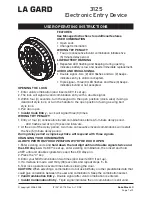
Active Noise Reduction
Active Noise Reduction (ANR)
is the function to cancel the noise component of the collected audio in order to improve
the transmitted audio quality.
The noise cancellation function can be collectively configured according to the usage environment. Also, selecting “Custom”
enables the detailed configuration of the noise cancellation function.
Table 6-22 ANR Preset
ANR Preset
Description
Off
The noise cancellation characteristics cannot be configured.
Light
Reduces the background noise. Reduces the background noise less effectively than “Standard”. On an analog
channel, the effect of the background noise reduction is the same as when “Off” is configured.
Standard
Reduces the background noise. Assuming a variety of environments, this configuration is for not
deteriorating audio.
Powerful
Reduces the background noise more effectively than “Standard”. Audio may be slightly
suppressed. Also, since the position of the microphone is being detected even while not
transmitting, this configuration is suitable for a user using the transceiver in a noisy environment
or with the microphone on the shoulder.
Professional
Reduces the background noise. This configuration reduces noise of a specific environment, such
as a siren, and is also harmless to audio.
The optimal noise cancellation effect is available by having the mouth of a transmitting user and
the microphone positioned at an appropriate distance when the transceiver is used. This
configuration is suitable for use in a fire department and a police station.
Custom
The following various functions of noise cancellation can be configured:
Vocoder:
In
Vocoder
, whether the transceiver transmits on a digital channel with or without reducing and
eliminating the noise component of the background noise can be configured. If the transceiver is
used in a noisy environment, enabling this function allows the transceiver to transmit by reducing
and eliminating the noise components in the background noise, so that the noise at the receiving
transceiver is eliminated or reduced. However, a part of the voice component is also reduced, and
this reduction may cause the received audio to be fuzzy. In such case, disabling this function results
in the transmitted audio resembling an analog voice signal, so the audio on the receiving transceiver
may sound natural.
DSP:
In
DSP
, whether to reduce and eliminate the background noise or not while transmitting can be
configured. This configuration can be configured according to the situation of the background noise
or usage environment. Using a microphone consisting of 2 microphones can be more effective.
Noise Attenuation Level:
In
Noise Attenuation Level
, the amount of noise reduction can be configured. The standard
configuration is 0 dB, and the sound quality is balanced with the amount of noise reduction. If -20 dB
is configured, the noise can be most effectively reduced while the sound quality degrades more easily.
If +10 dB is configured, the noise is least effectively reduced while the sound quality degrades less.
Low Noise Level Adjustment:
In
Low Noise Level Adjustment
, whether to stop the noise cancellation process automatically in
an environment where background noise is low can be configured. If this function is enabled, the
degradation of sound quality can be prevented in an environment where background noise is low.
Optimization based on Microphone Position (Portable only):
Whether to optimize the noise cancellation process according to the positional relationship of the
microphone and the mouth of a user can be configured. If this function is enabled, the positional
relationship of the microphone and the mouth is detected and the noise cancellation process is
optimized. This function is effective when the microphone is not held stable by a user or unable to
be used in front of the mouth. If this function is disabled, the noise cancellation process is not
optimized according to the microphone position. However, if the microphone is used in front of the
mouth, optimized noise cancellation is available. This function is valid when an internal microphone
or KMC-54 is used.
Siren:
In
Siren
, whether to remove the siren audio component when a siren audio is detected can be
configured.
6 SOUND
6.7 Configuring Audio Profile (Audio Profile)
Common FUNC (K, F)/Ver 2.20
136
















































